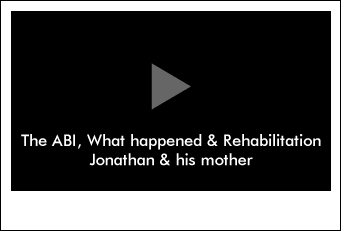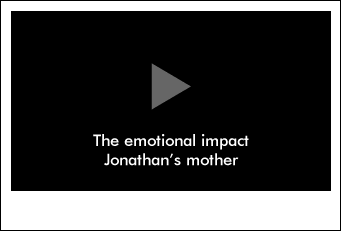- SELF STUDY MODULES
- 1. Intro to TBI
- 2. Communication
- 3. Skills for independence
- 4. Cognitive changes
- 5. Behaviour changes
- 6. Sexuality
- 7. Case management (BIR)
- 8. No longer available
- 9. Mobility & motor control
- 10. Mental health & TBI:
an introduction - 11. Mental health problems
and TBI: diagnosis
& management - 12. Working with Families
after Traumatic Injury:
An Introduction - 13. Goal setting
- 12.0 Aims
- 12.0A Take the PRE-Test
- 12.1 Why is working with families important
- 12.2 What is the adjustment experience for families
- a) The journey
- b) The challenges
- 12.3 Principles and skills
- a) Partnering
- b) Whole of family
- c) Family reactions
- d) Respect
- e) Empowering
- 12.4 When to get help
- 12.5 Take home messages
- 12.6 Resources
- 12.7 Take the POST-Test
12.2a The adjustment experience: The journey
- i) A family's
experience Video - ii) The
Journey Q - iii) The emotional
impact Video Q - iv) The research
evidence Q - v) Factors impacting
on adjustment
A family's experience - Jonathan and his mother (Video 7 mins)
Here is one family's experience.
Jonathan was hit by a car when he was 12 years old. He had a severe traumatic brain injury. At the time of the injury he had a very poor prognosis. He is now in his mid 20's living with his family.
The video may take a few moments to load.
As you watch the video jot down key points from the journey.
Key points from the Jonathan's family's journey
Before the accident
Jonathan 12 years old at the time
Average
Normal
Bright
Boisterous
Playing outdoors
Riding his bike
Playing musical instruments
High achiever
The injury
Crossing road on Sunday afternoon
Hit by a car speeding down the hill
Found minutes later
Blood
The nightmare began
Wasn't expected to survive
Intensive care for three weeks
Extremely severe traumatic brain injury
Poor prognosis
Sydney children hospital for 5 months
Prognosis was very poor at 5 months
Brought him home
Hospital services were being cut back
We felt we needed to do more
We develop an 8 hour per day home based program physio therapy, occupational therapy and speech retraining program
Supported by the out patients system
15-16 years of age
Discharged from the Children's Hospital but he wasn't able to go to an adult service because he wasn't old enough
We didn't fit in any where
Out patient from Melbourne hospital - travel to Melbourne every three months
Gradual return to school
As an adult
Slow speech
Movement issues
Fine motor shakes
The emotional impact (Video 3 mins)
The first 50 seconds of this video are the same as the introductory video in Section 12.1. Jonathan's mother goes on to provide further detail about the emotional impact in the remainder of the video.
The video may take a few moments to load.
Life turned upside down
Life turned upside down in a split second
My husband didn't cope terribly well at first
My other son shifted from pillar to post because I was in the hospital with Jonathan for five months
Enormous strain on the family unit
Holding it together steering it though
My role the navigator of the ship
Had to hold it together and steer it through
Find things for each member of the family to contribute
Never knew what Jonathan's potential was
Shock and grief
I came to terms with it straight away
Was in shock for a while, never in denial
Grief is a stage you just keep going though
Even 13 years later it still hits you sometimes -
For what may have been, what you have lost, what he has lost
Reached a happy place
We have reached a happy place but it has taken a long time to get there
Highs of lows of adjustment and re-adjustment
Coming together as a family
Needed help / accepted help / part of a team
Need everyone helping you
Need s sacred circle involving family, friends, therapists and clinicians.
It has to become a team
The research evidence
Overall
- Many families adapt well and show amazing strength once the initial shock and distress have passed. This is true both of families supporting someone with a traumatic brain injury (TBI) or a spinal cord injury (SCI).
- Long term family distress does not seem to be related to the severity of either a TBI or SCI
Traumatic Brain Injury
- Up to 50% of families supporting a relative with TBI go through some period of anxiety or depression.
- During the inpatient phase anxiety is more noticeable. Further down the track after discharge, feelings of depression seem to be more noticeable.
- Some studies have found that spouses have a harder time when their partner sustains an injury than parents do when an adult child is injured. However other studies have found no difference in the distress experienced by parents or spouses.
- The distress of families decreases when the family member feels that they have good social supports
Spinal Cord Injury
- Up to 50% of families feel psychological distress in the period leading up to the discharge of their relative with SCI. However by 1 year post-discharge, this can have dropped to under 20%.
- Up to 25% of partners feel as if they experience a heavy burden of care in supporting their spouse with a SCI.
- Partners who marry someone with a SCI are generally more satisfied with the relationship than spouses whose partner sustained a SCI.
- Over the longer term, spouses who did not have to play a significant carer role with their partner were generally less depressed
What percentage of families go through periods of anxiety and depression in supporting
their relative after traumatic injury
Internal and external challenges impacting on adjustment
In adjusting to traumatic injury there are:
- internal challenges (like feeling loss of control)
- external challenges (like finances and support networks).
Internal factors which impact on adjustment include:
Outlook
Flexibility
Ability to access support
Communication style
Feeling loss of control
Privacy
Hope
External factors which impact on adjustment include:
Injury Severity
Finances
Other family member needs
Family conflict
Providing care
Changed relationships
Outlook of person with injury
Social support
Lifestyle changes
Number of losses
Too much information
Role changes
Medical jargon
Cultural and religious difference
Ability to speak English
Legal issues
Education levels
Health
Role changes
Lack of privacy
Lack of time to rest and recharge
Life stage


